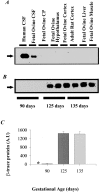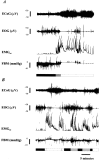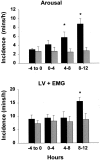Prostaglandin D synthase in the prenatal ovine brain and effects of its inhibition with selenium chloride on fetal sleep/wake activity in utero
- PMID: 12097519
- PMCID: PMC6758228
- DOI: 10.1523/JNEUROSCI.22-13-05679.2002
Prostaglandin D synthase in the prenatal ovine brain and effects of its inhibition with selenium chloride on fetal sleep/wake activity in utero
Abstract
It has been proposed that prostaglandin (PG) D(2) induces physiological sleep in mammals by acting on sleep centers located in the anterior hypothalamus. In fetal sheep, definitive rapid-eye-movement and non-rapid-eye-movement sleep states appear at approximately 125 d gestation (term is approximately 147 d). In adult animals, PGD synthase (PGDS) (functionally and structurally homologous to beta-trace protein) is secreted into CSF with a circadian pattern, with the highest concentrations present during sleep. In this study we show that PGDS/beta-trace protein is present in fetal sheep CSF at 125 and 135 d gestation but not at 90 d gestation. SeCl(4), a specific inhibitor of PGDS, was given to unanesthetized fetal sheep (130-140 d gestation) by intracerebroventricular infusion at a dose of 25, 100, 500, or 1000 pmol/min for 4 hr. Artificial CSF was infused in control experiments. Arousal behavior, defined as the presence of nuchal muscle electromyogram activity, electro-ocular activity, and breathing movements during low-amplitude electrocortical activity, increased from 3.8 +/- 1 min/hr to 6.6 +/- 0.5 and 7.0 +/- 0.3 min/hr at doses of 100 and 500 pmol/min, respectively (p < 0.05). SeCl(4) at 25 and 1000 pmol/min had no significant effect on arousal activity. Infusion of PGD(2) at 500 pmol/min intracerebroventricularly for 4 hr decreased the incidence of arousal from 3.8 +/- 0.5 min/hr to 0.7 +/- 0.3 min/hr (p < 0.05). When 500 pmol/min PGD(2) was infused immediately after a 4 hr infusion of SeCl(4) (500 pmol/min), the SeCl(4)-induced increase in arousal behavior was abolished. Together, the presence of PGDS/beta-trace protein in fetal CSF in late gestation and the effects of SeCl(4) in increasing the incidence of arousal-like behavior suggest that PGD(2) has a role in the induction and maintenance of prenatal sleep.
Figures








Similar articles
-
Lipocalin-type prostaglandin D synthase produces prostaglandin D2 involved in regulation of physiological sleep.Proc Natl Acad Sci U S A. 2006 Nov 21;103(47):17949-54. doi: 10.1073/pnas.0608581103. Epub 2006 Nov 8. Proc Natl Acad Sci U S A. 2006. PMID: 17093043 Free PMC article.
-
Intravenous administration of inorganic selenium compounds, inhibitors of prostaglandin D synthase, inhibits sleep in freely moving rats.Brain Res. 1993 Sep 24;623(1):65-71. doi: 10.1016/0006-8993(93)90010-k. Brain Res. 1993. PMID: 8221095
-
Inhibition of sleep in rats by inorganic selenium compounds, inhibitors of prostaglandin D synthase.Proc Natl Acad Sci U S A. 1991 Oct 15;88(20):9046-50. doi: 10.1073/pnas.88.20.9046. Proc Natl Acad Sci U S A. 1991. PMID: 1924366 Free PMC article.
-
[Prostaglandins and sleep].Nihon Rinsho. 1998 Feb;56(2):285-9. Nihon Rinsho. 1998. PMID: 9503823 Review. Japanese.
-
Molecular mechanisms of sleep-wake regulation: a role of prostaglandin D2.Philos Trans R Soc Lond B Biol Sci. 2000 Feb 29;355(1394):275-80. doi: 10.1098/rstb.2000.0564. Philos Trans R Soc Lond B Biol Sci. 2000. PMID: 10724461 Free PMC article. Review.
Cited by
-
Role of the L-PGDS-PGD2-DP1 receptor axis in sleep regulation and neurologic outcomes.Sleep. 2019 Jun 11;42(6):zsz073. doi: 10.1093/sleep/zsz073. Sleep. 2019. PMID: 30893431 Free PMC article. Review.
-
Association between Selenium Intake and Optimal Sleep Duration: A National Longitudinal Study.Nutrients. 2023 Jan 12;15(2):397. doi: 10.3390/nu15020397. Nutrients. 2023. PMID: 36678268 Free PMC article.
-
Does prostaglandin D2 hold the cure to male pattern baldness?Exp Dermatol. 2014 Apr;23(4):224-7. doi: 10.1111/exd.12348. Exp Dermatol. 2014. PMID: 24521203 Free PMC article. Review.
-
Lipocalin-type prostaglandin D synthase produces prostaglandin D2 involved in regulation of physiological sleep.Proc Natl Acad Sci U S A. 2006 Nov 21;103(47):17949-54. doi: 10.1073/pnas.0608581103. Epub 2006 Nov 8. Proc Natl Acad Sci U S A. 2006. PMID: 17093043 Free PMC article.
-
Waking up too early - the consequences of preterm birth on sleep development.J Physiol. 2018 Dec;596(23):5687-5708. doi: 10.1113/JP274950. Epub 2018 Jun 2. J Physiol. 2018. PMID: 29691876 Free PMC article. Review.
References
-
- Adamson SL, Richardson BS, Homan J. Initiation of pulmonary gas exchange by fetal sheep in utero. J Appl Physiol. 1987;62:989–998. - PubMed
-
- Beuckmann CT, Gordon WC, Kanaoka Y, Eguchi N, Marcheselli VL, Gerashchenko DY, Urade Y, Hayaishi O, Bazan NG. Lipocalin-type prostaglandin D synthase (β-trace) is located in pigment epithelial cells of rat retina and accumulates within interphotoreceptor matrix. J Neurosci. 1996;16:6119–6124. - PMC - PubMed
-
- Bissonnette JM, Hohimer AR, Richardson BS. Ventriculocisternal cerebrospinal perfusion in unanesthetized fetal lambs. J Appl Physiol. 1981;50:880–883. - PubMed
-
- Blodorn B, Mader M, Urade Y, Hayaishi O, Felgenhauer K, Bruck W. Choroid plexus: the major site of mRNA expression for the β-trace protein (prostaglandin D synthase) in the human brain. Neurosci Lett. 1996;209:117–120. - PubMed
Publication types
MeSH terms
Substances
LinkOut - more resources
Full Text Sources
Miscellaneous
